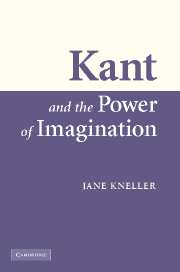Book contents
- Frontmatter
- Contents
- Preface and acknowledgments
- Introduction
- 1 Kant and Romanticism
- 2 The power of imaginative freedom
- 3 The interests of disinterest
- 4 Aesthetic reflection and the primacy of the practical
- 5 The failure of Kant's imagination
- 6 Imaginative reflections of the self in Novalis and Hölderlin
- 7 Novalis' Kantianism and Kant's Romanticism
- Bibliography
- Index
2 - The power of imaginative freedom
Published online by Cambridge University Press: 22 September 2009
- Frontmatter
- Contents
- Preface and acknowledgments
- Introduction
- 1 Kant and Romanticism
- 2 The power of imaginative freedom
- 3 The interests of disinterest
- 4 Aesthetic reflection and the primacy of the practical
- 5 The failure of Kant's imagination
- 6 Imaginative reflections of the self in Novalis and Hölderlin
- 7 Novalis' Kantianism and Kant's Romanticism
- Bibliography
- Index
Summary
Just as the concept of freedom is central to the political and moral philosophy of the Enlightenment, it is also important to the aesthetic theory of this period. This is clearly true of the German Enlightenment. Beginning with Baumgarten, the concept of the autonomy of the imagination in aesthetic judgment and artistic production becomes an essential feature of German aesthetic theory, culminating in Kant's detailed account of the free activity of the imagination in judgments about the beautiful.
A study of Kant's notion of imaginative freedom also reveals a continuity in German philosophy from Lessing to Schiller that is not apparent in other approaches to his aesthetic theory. That is, in spite of an apparent break with the German enlightenment tradition created by Kant's insistence that aesthetics is essentially irrelevant to morality, his account of imaginative freedom suggests the possibility that political and moral progress may be intimately connected with our ability to make universally valid aesthetic judgments. This in turn suggests that Kant's system left room for an “enlightened” commitment to the view that our experience of beauty and art may have an indispensable role to play in our moral improvement.
In what follows, I first briefly trace the development of the concept of imaginative freedom from Baumgarten to Lessing and then go on to outline Kant's account of this concept.
- Type
- Chapter
- Information
- Kant and the Power of Imagination , pp. 38 - 59Publisher: Cambridge University PressPrint publication year: 2007



